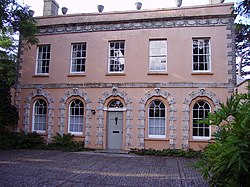Eleanor Coade
[c][d][e][f] Lithodipyra ("stone fired twice") was a high-quality, durable moulded weather-resistant, stoneware; statues and decorative features from this still look almost new today.
Coade did not invent 'artificial stone', as various inferior quality precursors had been both patented and manufactured over the previous forty years, but she probably perfected both the formulation and the firing process.
She combined high-quality manufacturing and artistic taste, together with entrepreneurial, business and marketing skills, to create the overwhelmingly successful stone products of her age.
In 1784 an uncle, Samuel Coade, gave her Belmont House, a holiday villa in Lyme Regis, her late father's town of origin.
[1][11] In early 1769 the family were living at St Thomas Apostles Street[12] when her father George Coade died that year, after having gone bankrupt for the second time.
[13] It was a simple two-storey Georgian seaside villa known as Bunter's Castle but renamed Belmont House by the Coade family.
From Eleanor Coade's will: I ELEANOR COADE of Great Surrey Street, Blackfriars Road in the parish of Christchurch in the County of Surrey, Spinster, in the fear of God who has blessed my labours amidst many afflictions to the accumulating some property which I now consider as a talent to be rendered back to Him whenever he shall see fit to remove me to that better inheritance which through the aboundings of his Grace in Christ he has enabled me as a chief sinner to hope for, pressed down with favours innumerable it is my desire to glorify him in the following distribution.
She is commemorated by the Coade Stone, placed under Westminster Bridge alongside the footpath to Royal Festival Hall, which now occupies the site of her factory at "Narrow Wall".
[19] In late 1769, at the age of 36, Eleanor Coade bought Daniel Pincot's struggling artificial stone business at Kings Arms Stairs, Narrow Wall, Lambeth, a site now occupied by the Royal Festival Hall.
[21][22] Pincot's business may have been related to that run nearby by Richard Holt, who had taken out two patents in 1722: one for a kind of liquid metal or stone, and another for making china without the use of clay.
It included statues; busts; whole panels; friezes; fascia; medallions; paterae; coats of arms; balusters; pinnacles; chimneypieces; furniture; interior ornaments; and mouldings.
She also opened a show room, Coade's Gallery, on Pedlar's Acre at the Surrey end of Westminster Bridge Road to display her products.
[28] The business continued to be successful long after Coade's death, but Croggon went bankrupt in 1833 because of both changing tastes and the failure of the Duke of York to pay his debts.
She was the first and only person to succeed in the artificial stone business, thanks to a combination of managerial skills, entrepreneurial flair, and a talent for marketing and public relations.
[5][25] The factory produced large ceramic statues and all manner of decorative architectural features, which proved to be extremely durable.
This material resisted corrosion by London's polluted air, made damaging by coal exhausts, formation of acid rain, and byproducts.
Coade stone works included the frontispiece of the original Twinings shop (tea merchants) on the Strand; private ornaments in the rear of Buckingham Palace; the lion on Westminster Bridge; the Nelson Pediment at the Royal Naval College at Greenwich[30] (the mural above the terrace's main entrance was reckoned by the Coade workers as the finest of all their work); the statue of George III on the seafront at Weymouth, Dorset; the stone awning and statues at Schomberg House, Pall Mall, London; and the crest on the Imperial War Museum.



Westminster Bridge, 1799.
(Engraving of the entrance to the premises by S. Rawle in 1802.)
